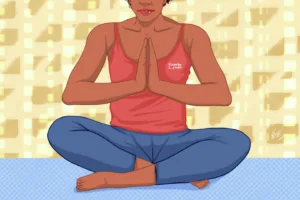Turning 50 Has Left Me Unsettled. Should I Give Meditation a Go?
By the time I turned 50, I’d accepted a few hard truths: I will never enjoy kale, I still don’t understand cryptocurrency, and—despite every wellness podcast and self-help guru’s insistence—I am just not a meditation person.
I’ve tried. Believe me. I’ve downloaded the apps. I’ve bought the lavender-scented candles. I even once sat on a cushion in a room full of strangers, trying to pretend that my foot wasn’t asleep and that my inner monologue wasn’t screaming, “Why are we doing this?”
The truth is, sitting still with my eyes closed just isn’t my thing. For over-thinkers like me, the kind who, in three seconds, drift from replaying a neighbourly row to meticulously planning the shopping list, meditating might seem dull. As the English comedian Sarah Pascoe might quip, “I tried meditating once. Three breaths in, and I’m drafting my grocery budget in my head.”
But I also knew I needed something or someone to help me slow down, especially after hitting the half-century mark, when everything from hormones to group texts seems a little louder and more exhausting.
So, I decided to redefine what mindfulness looked like for me. Spoiler: no chanting required.

Why Midlife Women Should Give Meditation a Go
I’m honest, I’ve tried all sorts of mindfulness practices that offer similar benefits without the need for stillness or silence. From mindful eating to mindful walking, including body scan meditation and the 5 senses exercise, nothing seemed to catch my attention until I met Sophie Lefèvre, founder of Breathe & Heal.
Sophie, once an international project manager, had left that world behind after discovering Transformational Breath®, a practice created by Dr. Judith Kravitz. It might sound like something out of a Marvel movie, but in reality, it’s deeply gentle and grounding.
Sophie’s real magic lies in how she helps late-blooming women reconnect—with their bodies, their energy, and their sense of purpose. “It’s about being present – she says- holding yourself, and taking responsibility for your own happiness. And that all starts with a single breath.”
She admits most women she works with—typically in their 40s and 50s—come in skeptical. “Most people think: I breathe every day. What could possibly change?” she says. “But once they experience a breathwork session, they’re blown away.”
From hot and cold flashes to tears, laughter, and even bursts of euphoria, the body begins to release old emotions and suppressed energy. “Everything that comes up is temporary,” she reassures. “But people leave feeling calm, grounded, and more connected to themselves. That’s the real surprise—and the beauty of it.”
Surprisingly, for Sophie breathwork became a game-changer after traditional meditation left her feeling like a failure. “A therapist once told me I needed to spend more time with myself, to be more present. So I tried to meditate—sat on my sofa, still for a minute, and my mind just exploded with thoughts. I couldn’t sit still.” It wasn’t until she found breathwork that things began to shift. “Suddenly I was doing something—I was actively breathing—and that activity helped me connect to myself. After that, I could meditate. My mind had quieted.”

Five Minutes a Day of Breathwork Can Make a Difference
She now practices daily, typically 15 minutes of breathwork followed by a few minutes of meditation, with longer sessions on weekends. But she’s quick to remind her clients: even two or five minutes a day can make a difference.
“What breathwork teaches you is awareness. So when you’re in a stressful moment—your boss calls you in, or you’re having an argument—you start noticing your breath. You can take a few deep breaths and regulate your nervous system in real-time.”
Sophie describes the technique she teaches as an integrative, conscious connected breathing method that works on physical, emotional, mental, and spiritual levels.
“It’s holistic,” she says. “We use the breath to work through suppressed and unconscious emotions—the ones that drive us even when we’re not aware of them.” And though resistance often shows up (the inner voice saying “I’m too tired” or “I don’t have time”), Sophie urges compassion. “Recognise it for what it is: fear of change. But the breath will guide you through.”
What to Do If You Don’t Like Meditating
So, did I give in? Not quite. I started small. At first, I felt silly. But then something shifted. My brain felt a little less like a browser with 47 tabs open. And my energy? It didn’t exactly roar back, but it definitely stirred
I haven’t joined one of Sophie’s classes yet. I feel like I’m still wandering a bit before fully committing. But online, I’ve found some helpful resources.
Here’s what I’ve actually managed:
- Box Breathing: Inhale for four, hold for four, exhale for four. A loo-based miracle.
- Wave Breathing: Belly first, then chest, then a big whooshy exhale. Sounds ridiculous, feels amazing.
- 4-7-8 Sleep Hack: Inhale 4, hold 7, exhale 8. Apparently it activates the vagus nerve. All I know is I fall asleep before I get to 7.
I’m not saying I’ve become some serene goddess who floats through life humming. I still get overwhelmed. I still burn the toast. But I’ve found tiny, doable ways to hit pause. And at this age, a pause is sometimes more powerful than a sprint.
Like this post? Support Us or Sign up to our newsletter to get more articles like this delivered straight to your inbox!






This Post Has 0 Comments